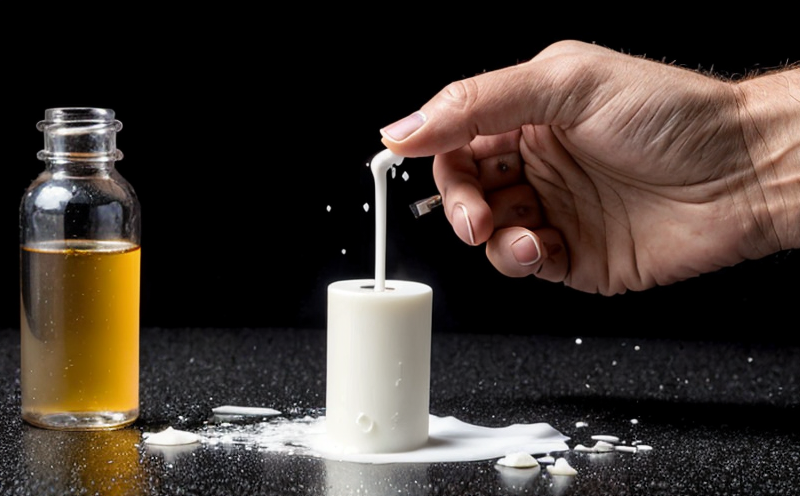USP Disintegration Testing of Suppositories
The United States Pharmacopeia (USP) disintegration testing is a critical procedure used to ensure that pharmaceutical products, including suppositories, are manufactured in accordance with stringent quality standards. This test evaluates the rate and degree at which a dosage form breaks down under prescribed conditions. For suppositories, the USP 703 method specifies the exact parameters for ensuring the product disintegrates within an acceptable time frame.
The process involves placing the suppository in a dissolution apparatus with a predetermined volume of water (typically 900 mL) and monitoring its disintegration over a set period. The apparatus simulates the conditions under which the dosage form will be used, ensuring that it meets both regulatory and clinical requirements.
The significance of this test lies in its role in preventing potential health hazards associated with delayed drug release or incomplete dissolution. Ensuring proper disintegration is crucial for effective drug absorption and patient safety. This procedure aligns with the broader goal of maintaining pharmaceutical quality, which is paramount in the healthcare sector.
Compliance with USP standards is mandatory for manufacturers seeking to produce products that meet international regulatory requirements. By adhering to these standards, companies can ensure their products are safe and efficacious, thereby gaining trust from both regulatory bodies and consumers alike.
The testing procedure involves several key steps: preparation of the sample, setting up the apparatus according to USP guidelines, initiating the test, and recording data. The results of this test provide valuable insights into the quality control aspects of suppository manufacturing, helping manufacturers identify areas for improvement.
Quality managers and compliance officers play a vital role in overseeing these tests, ensuring that all steps are followed correctly and consistently across production batches. R&D engineers benefit from understanding disintegration testing as it aids them in optimizing formulations to meet both regulatory standards and market demands. Procurement teams also need to be aware of this process since they ensure the reliability of raw materials used during manufacturing.
In summary, USP disintegration testing is an essential part of ensuring pharmaceutical quality. It helps manufacturers produce safe and effective products that comply with international regulations while maintaining trust in their brand among consumers and regulatory authorities.
Scope and Methodology
The USP disintegration test for suppositories is conducted using a basket-type apparatus, where the sample is placed within a perforated basket. This allows water to pass through while the suppository remains suspended in the fluid. The apparatus is designed to mimic real-world conditions that the dosage form might encounter during use.
- Test Conditions: The temperature of the water should be maintained between 37°C ± 1°C, simulating body temperature.
- Dissolution Time: For suppositories, the test is conducted for at least two hours or until complete disintegration occurs. During this time, the basket containing the sample rotates continuously to ensure uniform contact with the water.
The apparatus used in USP 703 testing includes a dissolution apparatus capable of holding up to 900 mL of water and equipped with a suitable basket for suppositories. It is essential that this equipment be calibrated according to USP specifications before each use.
Once the test begins, it continues until all parts of the suppository have disintegrated or until the specified time limit has elapsed. At regular intervals during the test, visual observations are made to assess any changes in appearance or texture that could indicate incomplete dissolution or disintegration.
The acceptance criteria for this test specify that 100% of the sample must completely disintegrate within two hours under these conditions. Any suppository failing to meet this criterion would be considered non-compliant and thus unsuitable for distribution.
For detailed information regarding the exact specifications required by USP, refer to their official guidelines or consult with an accredited laboratory specializing in pharmaceutical testing.
Environmental and Sustainability Contributions
Incorporating environmental considerations into disintegration testing can significantly contribute to reducing waste and promoting sustainability within the pharmaceutical industry. By ensuring that suppositories are manufactured according to USP guidelines, manufacturers not only enhance product quality but also minimize environmental impact.
Manufacturers who adhere strictly to USP standards often employ efficient production processes which lead to reduced energy consumption and lower carbon footprints. Additionally, using high-quality raw materials ensures less waste throughout the manufacturing process, resulting in more sustainable practices overall.
The results of disintegration testing provide valuable data that can be used by manufacturers to improve their sustainability efforts further. For instance, if a particular formulation consistently fails disintegration tests due to incomplete dissolution, it may indicate inefficiencies in production or packaging methods which could then be addressed through more sustainable practices.
Moreover, ensuring compliance with USP standards helps pharmaceutical companies meet global regulatory requirements, thereby reducing the need for multiple audits and inspections from various countries. This can lead to cost savings while also promoting better communication between different regions involved in drug development and distribution.
In conclusion, by focusing on rigorous disintegration testing practices such as those outlined by USP, manufacturers contribute positively towards environmental sustainability within their operations.





